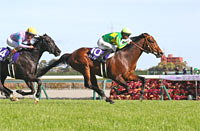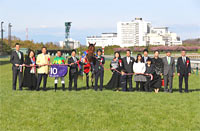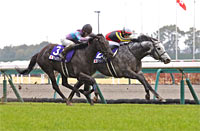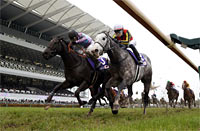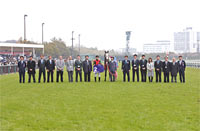2015 News
Data Analysis for the ”2015 Takamatsunomiya Kinen (G1)”Top-class performers enter battle for the title of spring's best sprinter The Takamatsunomiya Kinen (known as the “Takamatsunomiya Hai” until 1997) has been held as a 1,200m G1 turf race since 1996. Looking back at past winners of this race, the most recent one backed outside the top 4 favorites was Masa Lucky (8th favorite) in 1999; all 15 winners since then have been within the top 4 favorites. In fact, the Takamatsunomiya Kinen is the JRA’s only G1 race in which no horse backed below 4th favorite has won since 2000. So will a horse with strong pre-race billing take the spoils again this year? Or will an unexpected newcomer snatch victory and breathe fresh life into the short-distance turf racing scene? This time, let’s analyze trends in this race from results over the last 10 years (including 2011, when it was held on the 1,200m turf course at Hanshin, due to refurbishment work at Chukyo). Previous race: focus on race status and final placing First, let’s look at aggregate performances in this race over the last 10 years, based on the status of the runners’ previous race. The result is that no horse coming from anything other than “JRA graded races” has had any success here. Perhaps we should not expect too much of horses most recently contesting open stakes races, NAR races or overseas races. [Table 1] [Table 1] Performance by status of previous race (last 10 years)
Moreover, of runners most recently appearing in “JRA graded races”, those that were beaten to “5th or lower” in that race have not tasted victory here, and their top 3 ratio is only 5.8%. In other words, not only should the previous race be a JRA graded race, but the runner should have been placed among the top finishers in that race. [Table 2] [Table 2] Performance by finish in previous race when it was a ”JRA graded race” (last 10 years)
Record in graded races is another key point All 30 top 3 finishers over the last 10 years had previously experienced a top 3 finish in a JRA turf graded race. This suggests a poor prognosis for horses that have only experienced success in open stakes races, allowance races, NAR races or overseas graded races. [Table 3] [Table 3] Performance by experience of a top 3 finish in a JRA turf graded race (last 10 years)
Horses with no previous experience of a top 3 finish in JRA 1,400m+ turf graded races have a poor record in this race; not only have they provided no winners, but their top 3 ratio is only 9.9%. Our attention should be on horses with previous experience of a top 3 finish in graded races run over a longer distance than this one, rather than just those with success in turf graded races run over 1,200m or less. [Table 4] [Table 4] Performance by experience of a top 3 finish in JRA 1,400m+ turf graded races (last 10 years)
Again, horses lacking experience of a top 3 finish in turf graded races at Kyoto or Hanshin have not won this race over the last 10 years, posting a top 3 ratio of only 3.0%. It seems we should discount runners with previous experience of success only in turf graded races in the Kanto area or local racecourses. [Table 5] [Table 5] Performance by experience of a top 3 finish in turf graded races at Kyoto or Hanshin (last 10 years)
Focus on 5- and 6-year-olds Looking at aggregate performances by age over the last 10 years, we find no instance of success among “9-year-olds and up”, while both “7-year-olds” and “8-year-olds” have only achieved top 3 ratios of around 10%. This might prompt lower expectations of horses aged 7 and over. On the other hand, “4-year-olds” have only marked a top 3 ratio of 10.5%. In this race, then, our focus should be on the “5-year-olds” and “6-year-olds”. [Table 6] [Table 6] Performance by age (last 10 years)
Discount ”jockey change” runners Of 30 top 3 finishers over the last 10 years, 24 were ridden by “the same jockey as last time out”. Conversely, horses ridden by “a different jockey from last time out” have struggled, marking a top 3 ratio of only 8.8%. Runners coming to this race with a “jockey change” (different jockey from last time out) seem less likely to perform well. [Table 7] [Table 7] Look for horses backed as favorite in a G1 race last time out!
Outer brackets dominant in recent years Of nine top 3 finishers since Chukyo Racecourse was refurbished and reopened in 2012, seven had started the race in brackets “5-8”. By contrast, those in brackets“1-4” have not fared so well, with a top 3 ratio of only 8.3%. If recent trends are anything to go by, runners starting in the outer brackets would seem more likely to succeed. [Table 8] [Table 8] Performance by bracket number (last 3 years)
Seek out the winners! All ten winners over the last 10 years had finished their previous race within the top 4 places. Other statistics shared by these ten are that they had all experienced a top 2 finish in a JRA 1,400m+ turf graded race and a top 3 finish in a turf graded race at Kyoto or Hanshin Racecourse. Runners meeting the conditions set in Tables 1-5 must be leading candidates again this time. Incidentally, all six winners since 2009 also had previous experience of winning a 1,400m turf graded race at Hanshin. This could be another important pointer. [Table 9] [Table 9] Winners’ finish in the previous race, highest finish in JRA 1,400m+ turf graded races, highest finish in turf graded races at Kyoto or Hanshin, and highest finish in 1,400m turf graded races at Hanshin (last 10 years)
(Data analysis by Masaya Ibuki) |
|















